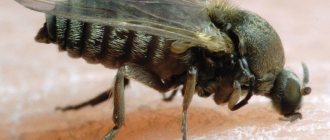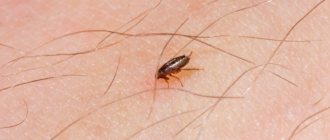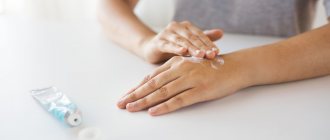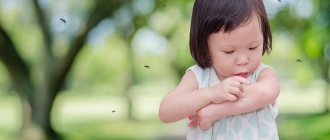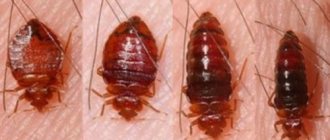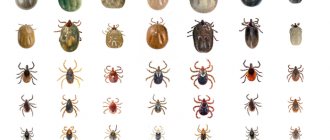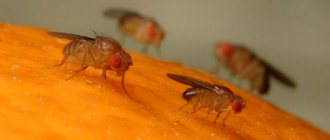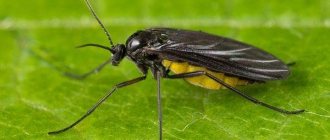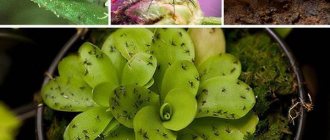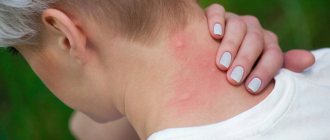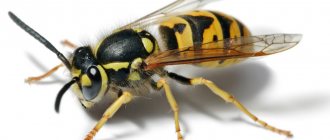Pest bite area
In general, midges do not choose where to bite their prey.
They bite wherever necessary (forehead, arms, legs, stomach), wherever they find areas of skin not covered by clothing. Despite this, they can also bite under clothing, in which case you will find bite marks on the thighs and stomach.
Places where pests accumulate are places with high humidity.
They also love hot weather. In the evenings, pests also become more active. Usually, the victims are people who spent the weekend at their summer cottage. Interesting fact
During the war, a person sentenced to execution served his sentence as food for midges. He was brought to a place where pests were concentrated, undressed and tied up. The condemned man died a painful death from numerous insect bites.
Food preferences
This insect has its own food preferences. Adult females feed on the blood of humans, cattle, horses, sheep, goats, poultry, other domestic animals, wild mammals and birds. Each midge species may prefer one type of host over another.
This is a diurnal biting insect that prefers calm weather. They are not limited to shaded, damp places and do not fly into enclosed spaces.
They find victims at a distance by smell, warmth, and sight. Females swarm around, crawl over the body, preferring the head, hair, ears, as well as any skin that is available.
Learn more Recipe for boric acid against ants in an apartment or country house
Their bites can itch and last for several days. Biting is accompanied by cutting through the skin and feeding on a pool of blood that accumulates on the wound.
Anticoagulants injected at the site of injury can easily provoke a mild or sometimes severe allergic reaction in sensitive people. Their attack is very painful due to the hole that is cut into the skin.
Some people are very attractive to the pest and have strong reactions to their bites. Others do not attract flies and get bitten little, if at all.
Consequences after a midge bite
The reactions that can be caused by a bite are different.
A person who has never complained of allergic reactions may also suffer. Reactions are divided into local (itching, which is unbearable, redness and subsequent swelling, if the midge has bitten the lower limbs, the person’s gait may be difficult); general (high temperature, weakness in the body, headaches. And if you have a tendency to allergic reactions, then in this case the body may become covered with blisters not only in the affected areas of the skin).
The swelling itself may go away within a few days. But the itching may torment you for several weeks. Itching can develop into scratching, which will also take a long time to heal on your body.
Where do midges come from?
Tiny flies can often be seen above spoiled vegetables and fruits. These insects become active mainly in the summer heat .
Their appearance on the street can always be explained, but where do these small insects come from in a house where all the windows and doors are closed?
Miniature sizes allow flies to penetrate even the smallest cracks (including sewer holes). The main habitats of small pests in the house are the kitchen and flower pot .
1.5 thousand species of in the world . The most famous are:
- The black midge is a small insect that bites very painfully. After a blackfly bite, irritation, an allergic reaction, itching and even swelling appear on the human body. Black midges can be domestic or ground flies (due to their small size and the same shade, they are often confused). When they bite, these insects make a slight incision in the skin, injecting a little anesthetic liquid . That is why a person does not feel pain immediately, but some time after the bite, when the effect of the anesthetic substance stops;
- White midge or fruit fly. This species does not pose any threat to humans, but the insect will be dangerous for garden fruits and vegetables. White midges lay their larvae on fruits and leaves of plants, causing them to spoil and die.
Reasons for appearing in the kitchen
The following factors contribute to the appearance of midges in the kitchen :
- Unwashed dishes;
- Filled trash can;
- Dirty pet bowls;
- Packages and bags of cereals;
- Open jar of jam;
- Uneaten vegetables or fruits.
Reasons for appearance in indoor flowers
Indoor flowers are also often the cause of small flies. larvae in moist soil poured into a flower pot .
Midges can appear even with proper care of the flower and timely watering. And if they manage to lay the larvae in the soil, they will subsequently gradually undermine the roots of the flowers .
The activity of the larvae ultimately leads to the fact that the roots of the plant begin to rot and the flower dies .
There are several reasons for the appearance of flower midges:
- Excessive soil moisture . In the summer, many housewives flood their plants, thinking that they lack moisture. Because of this, water stagnates and favorable conditions for the reproduction of midges develop;
- Poorly disinfected soil causes the development of putrefactive processes in the substrate (the nutrient medium in which flowers grow). Pest midges love to lay their larvae in such soil;
- Midges can enter the house through open windows and take up residence in the moist environment of a flower pot.
Read about how to grow dill on a windowsill in our next article. And here you can learn the features of growing lemon from seeds.
What signs can be used to understand the severity of a reaction to a midge bite?
Factors that will help you understand how reactions to a midge bite are expressed:
- Age range.
More mature people can easily tolerate midge bites. For children, bites can subsequently affect them in the form of an allergic reaction. Infants suffer the most danger from midge bites. For them, this can develop into a serious illness. - Immunity.
If the immune system is weakened, the reaction to a midge bite can cause allergic reactions. Age range does not matter here. - Increased sensitivity to midge saliva.
All pests contain an irritating reagent in their saliva, the body’s reaction to which cannot be predicted. If the human body is sensitive to this reagent, then insect bites must be avoided. - Pregnancy and lactation.
During pregnancy and breastfeeding, a woman’s body is weakened significantly. If before pregnancy a woman tolerated insect bites normally, then during this period there can be serious consequences.
Which midges can bite, and which are safe for people and animals?
This is a very common insect. It can be found in every corner of our planet, with the exception of Antarctica. On other parts of the land, these dipterans live everywhere, except for a number of remote islands and deserts devoid of natural bodies of water. You can become a victim of their attack anywhere: in taiga forests, on the sea coast, high in the mountains, in the country and even in a city apartment. Typically, midges attack on hot days near bodies of water.
Currently, 1500–2000 species of these insects are known. About 560 of them are found in our latitudes, some of which pose a serious danger to humans and animals. An allergy to a midge bite is not the most important harm that these insects can cause. They are also carriers of dangerous diseases that pose a potential threat to human health - plague, leprosy, anthrax, etc.
You shouldn't expect an attack from every midge. For example, Drosophila (fruit fly) is not dangerous to humans. Usually these insects appear in apartments, namely in the kitchen. They are attracted to rotten fruits and vegetables, sweets and fermented alcoholic drinks. They may also target wet rags, sinks and waste accumulations. Another species - ground flies - is dangerous only for plants.
Information about biting and, accordingly, posing a serious danger to warm-blooded varieties of midges is presented in the table:
| Types of blood-sucking midges | Dimensions, mm | Color | Habitat |
| Decorated (spotted) | 3–4,5 | Silver border on the back. The color of the antennae and body depends on the subspecies. | They live everywhere. |
| Horse | 2,5–4 | The back and abdomen of females have silvery-golden pubescence. In males, silvery spots are located on the upper part of the body. | They are found in heavily polluted natural bodies of water. |
| Redhead | Up to 3.5 | They have red compound eyes. Females have yellow limbs. | They live in Europe and the European part of Russia. They live in the channels of large muddy rivers. |
| Tundra | Until 3 | Males have a black-silver back with golden pubescence, females have a gray-black back and a rich yellow belly. | They live in the northern regions. |
| Short-palpid | Black body with silver spots. | The habitat extends from Karelia to the Arkhangelsk and Moscow regions. | |
| Silver | 3,5–3,8 | The back of males is decorated with silvery spots; in females they are of a more saturated shade. The paws are brown-black with a yellowish tone. | In addition to Russia, they are found in Western Europe and North America. |
| Light-browed | Up to 4 | Males have dark limbs, females are dark brown. | They are found in the northeast of Europe, in the European part of Russia and Transbaikalia. |
First aid after a midge bite
If midges bite you while outdoors, you must immediately treat them with any solution that contains alcohol.
After this, treat the bite with insect repellent. Nowadays, people do not go on vacation without these funds. If a midge has bitten you at home, the first thing you need to do is treat the wound with folk remedies to prevent the development of swelling.
What antiseptics are recommended for treating a bite?
Chlorhexidine;- Miramistin;
- Boric acid;
- Furacilin solution.
To prevent the swelling from “growing,” you need to apply ice in a cloth wrap to the bite area. If you do not wrap the ice in a cloth, you may get frostbite on your skin.
How to protect yourself from midge bites: the best repellent spray
Midges are attracted to exposed areas of the body - so when going for a walk in the summer in the early morning and late evening, if possible, wear long sleeves. If there are too many midges, use repellent to protect you and your family, especially if you are all hiking together or live in a swampy area. But which repellent is better to choose: chemical based or natural?
The best natural and chemical repellents
Entomologists recommend using DEET-based repellents for these purposes, which are used to protect against mosquitoes if they are labeled as protecting against biting midges. Therefore, you can safely use proven DEET-based repellents like Repel 100.
Aerosol Gardex Extreme Super against midges and other insects
Gardex Extreme Super repellent aerosol for 300 rubles is one of the most popular and powerful insect repellent sprays, which contains as much as 50% DEET! It promises to protect not only from mosquito bites and ticks, but also from midges and midges, and, judging by the satisfied reviews of users, it succeeds. True, buyers agree that the effect of one application is not very long-lasting. But, probably, if in your area the problem with midges has become a nightmare, 1.5 hours is already a success, don’t you agree?
What should those who don’t want to use chemicals to protect against midges do? We recommend that those with sensitive skin, which should not use chemicals, as well as pregnant women and children, pay attention to natural repellents. Essential oils in their composition are responsible for protection against biting midges and midges. The following product has proven itself quite well - Gardex Extreme Super
Price: 314 rub.
Insect repellent “Dobrohim “Antignus”
This natural repellent for 160 rubles promises to save you from attacks of biting midges near water bodies. Plus, it smells nice: active ingredients include geranium, mint and clove oils. For many families, this spray has become indispensable: it is also used to protect children and dogs while walking.
Price: 165 rub.
Relieving inflammation
Inflammation occurs when we begin to scratch the affected area.
To completely prevent inflammation, you need to take a comprehensive approach to treatment. Ointments and lotions will give you a positive effect. If it was not possible to remove the inflammation with the help of ointments and lotions, and the inflammation continues to “grow,” then the following maneuvers must be performed daily:
- Treating the wound with soapy water. It is advisable to use 72% laundry soap.
- Lubricate the irritation with any antiseptic. It is important to ensure that this product does not get into the wound itself.
- 2 hours after applying the product, lubricate the wound with ointment (levomekol, you can even use Vishnevsky ointment). It is recommended to lubricate the wound at night.
- After a while, as the ulcer formed after the bite begins to heal, you can begin to make lotions. Flocks of herbs (chamomile, sage, etc.). Wet a cloth with the solution and apply it to the wound.
Important point.
If irritation begins to worsen, consult a doctor. Of particular concern should be the appearance of black spots on the skin.
Symptoms of an insect bite
Midges release the chemical into the bloodstream as they feed on blood. This process can be expressed by scabies, redness and swelling. Symptoms intensify over time. Damage may be accompanied by the release of clear fluid.
The sting of a midge can provoke the appearance of several uncomfortable manifestations on the skin, namely:
- Severe itching that occurs after several hours. This is the primary sign of an allergic reaction;
- Manifestation of redness. This manifestation can be reflected by simple redness, but in some people it manifests itself as the appearance of red bumps, which is most often encountered by people with hypersensitive skin;
- The most dangerous and unpleasant manifestation is swelling, which can also occur due to skin hypersensitivity. If this occurs, you should consult a doctor to prevent various complications. For example, various skin inflammations or dermatitis.
- Blisters. Such manifestations do not occur in everyone, but still, they can be a consequence of a midge sting. In such cases, you should also seek medical help.
Edema
- When an insect bite occurs, symptoms appear, which may intensify over time.
- One of the first manifestations of wounds caused by midges is swelling.
- The first manifestations of the lesion do not appear immediately, but after some time.
- The midge introduces poison into the human body, the damaged area of the skin begins to swell and the area of edema may increase.
- This symptom may not appear. It depends on the individual reaction of the body.
Itching
- The next consequence of skin damage by insects is scabies, which affects everyone differently.
- In some cases, a person may not experience itching if the skin is not sensitive, but in almost all cases severe itching with severe burning occurs.
- Itching is a normal reaction of the body, which occurs as a result of damage to skin tissue and the introduction of poison to the body.
- Usually the itching goes away on its own, but to avoid discomfort it is recommended to use special medications that can help reduce the itching.
red spot
- After an insect bite, redness may appear as a consequence of the body's reaction to the introduction of poison.
- Redness may appear immediately after the bite and usually goes away within a few hours.
- If redness appears, you should not do anything; there is nothing to worry about.
- The most dangerous thing is the appearance of edema.
What remedies will help get rid of irritation and itching?
A midge bite causes severe itching, which can develop into nervous anxiety. How to treat it? Folk medicine and traditional remedies come to the rescue.
Ointments and gels
- Fenistil.
- Sinaflan.
- Psilo balm.
- Momederm.
- Betazon.
- Prednisolone.
- Hydrocortisone.
Regardless of their pharmaceutical affiliation, all of the above remedies will help you fight unbearable itching.
What are the consequences of a bug bite
Like most bites, bug bites are simply reddish spots on the skin with a mark from the inserted proboscis. Most often, the bug leaves a peculiar series of such bites (3-7 pieces each). If you spot such a path on your body, you know that bedbugs are biting you!
If there is a large infection or a person is sensitive to its bites, an allergy may develop. This puts children at risk of developing anemia. The rashes from the bites are too profuse, and in some cases they can fester. This causes a lot of discomfort.
We invite you to familiarize yourself with: Photos of flea bites on a person - how and how to treat them
Bed bugs are clear carriers of many infectious diseases through their bites, but there are no recorded cases of transmission of hepatitis and HIV infection.
Swelling after a midge bite. How to deal with it
- Baking soda.
You will get the effect from it: it relieves swelling, lowers the pain threshold and reduces itching. How to prepare the solution? Add 1 teaspoon of soda to 250 ml of water. Wet a cotton swab with the resulting solution and wipe the infected area. - Plantain or parsley juice.
The effect will also help reduce pain and itching. - Essential oils.
It is recommended to use both in pure form and to make a solution. The method of application is the same as described above. How to prepare the solution? 1 tablespoon of vegetable oil and 5 drops of any essential oil. Also wet the swab and apply it to the infected area.
Further treatment of bites
Even quick elimination of edema cannot prevent damage to the skin. Often, in people with low body resistance to bacterial infections, small wounds begin to fester and turn into multiple ulcers. At this stage of treatment, one cannot do without the use of ointments for midge bites with antimicrobial and antibacterial activity. What a dermatologist can prescribe:
- Levomekol;
- Levosin;
- Tetracycline ointment;
- Syntomycin ointment;
- Erythromycin ointment.
To quickly heal damaged skin, creams and ointments with epithelium-regenerating properties are used:
- Dexpanthenol;
- Panthenol;
- Bepanten.
The use of such ointments helps to quickly restore the skin even after ulcerative lesions without the formation of scars. They have a delicate consistency, are well absorbed and can be used in the treatment of midge bites in newborns and pregnant women.
Recommendation: Pharmacies have a wide range of essential oils of medicinal plants. Preparations made from chamomile, string, mint, lemon balm or sage will help eliminate swelling of the skin. To prepare an external remedy, you need to dilute a drop of essential oil in a tablespoon of water, moisten a cotton pad and apply it to the swelling.
Any complications after the bite? Treatment options
Signs of complications:
- Heat;
- Headaches and dizziness;
- Formation of pustules in the affected area;
- Spots and scars appeared after the wound healed.
All these symptoms indicate that you are experiencing complications.
You can relieve fever and headache with conventional antiviral drugs (Ibuprofen, etc.). Signs of intoxication - here medications such as enterosgel, white coal will help you.
Aloe.
A folk remedy that will help you replace all pharmaceutical products and save your budget.
How to apply aloe?
Rinse the aloe leaf well and scoop out all the pulp using a spoon. Cut in half and place on a napkin. First, the wound should be treated with any antiseptic; after 15 minutes, apply an aloe leaf to the wound and tie it with a bandage.
Effect:
Aloe not only disinfects and increases wound healing time, but also relieves itching and inflammation of the wound.
If you find spots on the skin, you can use products such as: Bruise off, Badyaga and other products designed to treat bruises and abrasions.
If hardening is detected inside the wound, it is recommended to use absorbable compresses, for example, Dimexide.
Dilute it in water in a ratio of 1:4 and apply a gauze pad soaked in the solution to the cone.
This product may cause skin burns if overused. The optimal holding time is no more than 40 minutes.
What should you do if your leg or arm is swollen, painful and itchy after an insect bite?
Treatment of a victim of a midge bite should begin with first aid. This will prevent the occurrence of negative consequences and alleviate the condition of a bitten child or adult. Only after this can you begin symptomatic therapy aimed at getting rid of swelling, itching, burning, pain and redness.
First aid for victims - adults and children
If a child or adult has been bitten by these insects, the first thing to do is:
- Determine the location of the lesion and remove any remaining saliva from the wound. To do this, gently squeeze the skin several times.
- Wash the wound with plenty of running water and baby or laundry soap to wash away any remaining saliva.
- Dry the wound with a clean napkin using light blotting movements.
- Treat the affected area with an antiseptic (Furacilin, Chlorhexidine).
After providing emergency assistance, victims, especially children, should not be left unattended. If the bitten person’s health has worsened, and the affected area hurts unbearably, has become even more swollen and red, it is necessary to take him to the hospital.
Symptomatic therapy: how to relieve swelling, reduce pain and itching?
If a person has become a victim of a midge bite, after which the affected area is swollen, redness and severe itching appear, and this happens in most cases, measures must be taken to alleviate his condition. Symptomatic therapy can be based on the use of pharmaceutical preparations for external use (ointments, gels) or folk remedies. It all depends on the severity of the discomfort.
Pharmacy drugs
It is not enough to apply ointment or gel to itchy and swollen skin once. It is necessary to smear the affected area until itching and swelling are completely eliminated. Topical products should be used in strict accordance with the manufacturer's recommendations. This is the only way to quickly and without the risk of further aggravating the situation to eliminate the consequences of the bite of these insects. The table provides information about which ointments and gels can be used to do this:
| Type of body reaction to an insect bite | Drugs | |
| Itching | Local antiallergic drugs | gel Fenistil, Psilobalm |
| Edema | Hormonal decongestant ointments | Hydrocortisone, Sinaflan, Trimistin |
| Wound infection | Antiseptic ointments | Levomekol, Oflocain, Levosin |
| Violation of the integrity of the skin | Regenerating agents | Panthenol, Solcoseryl, Bepanten, Actovegin |
If there is extensive swelling that extends to skin areas distant from the site of the lesion, you may need to:
- injection administration of antihistamines (Tavegil, Suprastin, Diphenhydramine);
- use of glucocorticosteroids (Dexamethasone, Hydrocortisone, Methylprednisolone);
- treatment with decongestants (L-lysine escinate, Mannitol, Furosemide).
When using hormonal ointments, one nuance must be taken into account. If you apply them to open wounds, it will cause a strong burning sensation and slow down tissue regeneration. It is recommended to apply them along the edges of wounds.
Folk remedies
If an insect bites you on the leg or arm and a mild reaction is observed in the affected area, folk remedies will come to the rescue. When using them, you need to know for sure that the bitten person tolerates the components included in their composition well. The table provides information on what methods, based on the use of natural ingredients, can treat the consequences of bites from these representatives of dipterans:
| Types of body reaction to an insect bite | Components | Preparation | Application |
| Edema | Dandelion or plantain | Knead the thoroughly washed plant with your hands. | Apply the plant to the affected area, securing it with adhesive tape. |
| Onion | Grate the vegetable on a fine grater. | Apply onion or potato pulp to the swollen area. | |
| Potato | |||
| Itching | Peppermint paste or mouthwash | Not required | Apply paste to the itchy skin or wipe with a cotton pad soaked in mouthwash. |
| Boric alcohol or aqueous solution of boric acid | Treat the affected area with liquid. | ||
| 3% vinegar | Mix vinegar and water in equal proportions. | Make a compress by applying a piece of gauze soaked in the product to the itchy skin on your leg or arm and securing it with an adhesive plaster. | |
| Salt | Dilute 1 tsp. salt in 200 ml of water. |
If a midge bites you on the face. What to do
The favorite place for midge bites is the face and neck.
They especially like to bite in unprotected places on the body (the mouth and around the eyes). If a midge bites in these places, you will feel the effect immediately when the poison enters the blood.
The eye will immediately begin to swell, which can lead to short-term vision loss.
If the site of infection is the area of the lips, then the lip will immediately begin to enlarge and it becomes problematic to talk.
Face
– a dangerous area for pest bites. If this happens, you must immediately take measures to prevent the development of complications:
- Apply antiallergic cream to the affected area of skin. In this case, drugs from the corticosteroid group are suitable;
- It is necessary to drink as much water as possible in order to remove all toxins as quickly as possible.
- Apply a compress of grated potatoes to the sore spot. This product will help cope with itching and cool the skin;
- Parsley juice will help deal with swelling. Wash fresh herbs, chop finely, place in clean gauze and squeeze well. Apply a damp swab to the bite site.
Important point. Never rub your eyes with your hands. If the mucous membrane is inflamed, the percentage of infection penetration increases significantly.
Bites
Those who are faced with the appearance of midges in their apartment wonder whether midges bite. It does not dig in with its sting, but tears out pieces of skin, even microscopic ones. The midge is smaller in size than a mosquito, but bites much more painfully. The insect's saliva gets into the resulting wound and causes an allergy. It can manifest itself in various ways:
- Redness of the skin at the site of the bite;
- A small wound in the middle of a reddened area of skin over a large area;
- Burning and pain;
- Swelling of the tissue and itching in it;
- Various types of rashes;
- When scratching, the wounds may become covered with a black scab;
- With multiple midge bites, body temperature may increase;
- Heartbeat quickens;
- Lymph nodes are enlarged;
- The pressure drops.
Midge bites
Interesting! Midges do not bite at night when a person is sleeping in bed - they are active only during the day. That is why the bed and bedding are not of interest to this insect - while destroying the parasite, you can think about treating the bedroom.
Patients of allergists who came with complaints about biting insects and wondered why midges bite, because they do not eat meat. The fact is that many of these creatures are blood-sucking. By making a hole in the skin, midges feed on the droplets of blood that appear.
What you should never do after a midge bite
- Household chemicals. Anything containing chemicals is strictly prohibited. The exception is laundry soap.
- If ulcers appear from scratching, they must be handled carefully. Do not allow alcohol solutions to get into open wounds.
- If a midge bites a baby. In this situation, consult a doctor immediately. Do not take self-medication, this can turn into a tragedy, since the baby does not have a strong immune system.
- Minimize scratching. If you really want to, it is also advisable to abstain. This can lead to infection in the infected area of skin.
- Corticosteroids should not be applied to an open wound. They cause a burning sensation and slow down tissue regeneration processes.
How to treat the consequences of bites
They react to a midge bite in different ways. The most annoying thing is itching, which leads to scratching and the appearance of microscopic lesions on the skin where the infection gets. After this, purulent inflammation has to be treated. Swelling in itself is not painful, but if it does not go away for a long time, occupies a large area or is located near the lips, eyes, or in the neck, then it interferes with normal life activities.
After a midge bite, it is necessary to begin treatment immediately to relieve the itching sensation and stop the spread of toxins.
How to proceed:
- rinse the skin with water, wipe dry;
- cool with ice, wrapping it in a bandage, towel, or some cold object;
- press the bite area with your palm and bandage;
- to treat a bite, you can use an alcohol-containing substance, chlorhexidine, Miramistin, hydrogen peroxide, furatsilin solution;
- relieve pain with paracetamol, Claritin, Diazolin;
- if rashes appear, then lubricate with Fenistil, Cynovit, Hyoxysone, Prednisolone;
- lotions with soda solution (1 tsp + 200 ml of warm water) relieve itching or reduce its manifestations.
Note! If a midge has bitten a child, you need to be especially careful, because they experience pain, swelling and itching are more pronounced, and even a single bite is dangerous. Hormonal drugs cannot be used; it is recommended to use Fenistil-gel, Zvezdochka balm, and Gvozdika cologne.
The skin itches for a long time, this interferes with sleep and work, and pain appears at the site of scratching. To prevent this, you can apply novocaine (0.5% solution), alcohol (1:2) dressings. Soothes with a light massage, stroking, patting with fingertips after lubrication with Menovazine or other products with menthol.
Bite infection
If the itching does not go away for a long time, purulent discharge may appear at the site of scratching - this means that dirt has been brought into the wound and putrefactive processes have begun to develop. At the first signs of discharge, it is necessary to begin therapeutic measures so that the process does not lead to deeper tissue damage:
- Wash the damaged skin well with soap and water;
- thoroughly treat with chlorhexidine, Decasan, hydrogen peroxide;
- apply an ointment that stops the development of a bacterial infection (Levomekol, Oflokain, Synthomycin Liniment, Levosin), bandage it;
- when the wound begins to heal, apply a bandage with Bepanten, Dexpanthenol, Panthenol, Actovegin, Methyluracil, Solcoseryl.
If the healing process is delayed, then medical assistance is necessary. Sometimes it is necessary to treat with antibiotics and clean the wound.
How to treat swelling
Swelling of soft tissues is one of the manifestations of the action of toxins. The swelling may occupy a small area, or it may begin to affect nearby areas.
Measures to relieve swelling after a midge bite:
- exposure to cold (ice, chilled metal);
- apply a bandage, squeeze the surface with your fingers;
- use alcohol (1:1 solution) and salt lotions (1 tsp + glass of water);
- rub with boric alcohol;
- apply ointments that relieve swelling (Hydrocortisone, Sinaflan, Trimistin, Triderm, Kremgen);
- for severe swelling, take Tavegil, Loratadine, Diazolin, Escinat, Furosemide, Manit.
Important! Particular attention should be paid to swelling in the respiratory area. If it grows quickly, then you need to provide access to fresh air to the victim and call a doctor. Such swelling should be treated by a specialist
Such swelling should be treated by a specialist.
Such swelling should be treated by a specialist.
Bite in the eye
Its small size allows the insect to crawl under clothing, into the ear, and sometimes it gets into the eye and causes a bite. The delicate skin around the eye instantly swells, begins to itch, and if prone to allergies, becomes inflamed. If the treatment is applied incorrectly, complications may arise, so consultation with a specialist is required.
First aid:
- Rinse the skin and mucous membranes with cold running water;
- take an antihistamine;
- lubricate the eyelids with Hydrocortisone, Dexamethasone;
- make a compress from cotton wool with parsley juice and green tea infusion;
- Apply a compress with a soda solution (1 tsp + glass of water) to the swelling;
- try not to scratch near the eye, so as not to provoke infection by scratching.
In what cases is it necessary to urgently consult a doctor?
It is necessary to seek medical help if:
- You have tried all the methods, but nothing helps, and the effect of infection only intensifies, you need to consult a doctor as soon as possible.
- If there is a possibility of developing anaphylactic shock, call an ambulance immediately.
- If you follow all the recommendations and do everything according to the instructions, but the symptoms do not disappear, it is also recommended to consult a doctor.
General information and video - how a midge bites
This is a video, at twice the normal speed, of a fly increasing its body weight in 60 seconds. The consequences were a wound on the leg that bled for several minutes.
Even the most powerful repellents cannot save you from this pest, which attacks throughout the day. These tiny flies are incredibly abundant in forested areas during the spring and summer.
Unlike mosquitoes, which insert their proboscis subcutaneously into small capillaries, the fly uses jagged jaws to injure tiny blood vessels.
Only the female black fly feeds on blood, using this rich source of protein to produce up to 800 eggs in its short life.
Males are the gentle sex and feed on nectar from flowers. The female lays eggs on rocks, logs, emergent vegetation, or directly into the water. The eggs hatch and the larvae feed on small plants and animals.
Terrible reddish blisters and swollen legs are the work of the midge.
The wound is enough to be noticed. Although the bite itself contains anesthetics contained in their saliva, the consequences can be quite unpleasant.
The wounds are reddish-purple in color, like blood stains under the skin. These red blisters are accompanied by intense itching that lasts for several days. Swelling is observed, the skin becomes elastic to the touch.
Fortunately, without medical attention, the swelling subsides within a few days. Although, red spots may be visible for up to a week after exposure to these tiny vampires.
The direct damage they cause is the lesser of the evils from these little flies. In several countries in Central, South America and Africa, they carry filarial worms that can live in the human body. They are small tumors under the skin.
Sometimes, filarial worms take up residence in the eyes and lead to vision loss known as river blindness or Robles disease.
How to avoid midge bites
Midges bite unnoticed and it is not always possible to feel their bite, so if you know that you are going to travel to nature or to the country, be sure to take precautions:
- Don't wear perfume. This attracts midges.
- Dress to show as little skin as possible.
- It is better to wear clothes made from natural fabrics.
- Apply products that repel midges. Please read the instructions before applying.
- The smell of food also attracts pests. When you sit down to eat, be sure to cover as much of your body as possible with clothing.
If you live in an apartment or house, you can also become victims of midges.
This is where electric fumigators will come to your aid.
If you take all protective measures, then you will not be afraid of any pests and the summer will pass 100%.
How to get rid of midges
The method of disposal depends on what kind of midges bite. The most commonly used remedy for midges is Dichlorvos, which cannot be called safe for humans and pets, and other aerosols. Therefore, it is better to use modern means against biting midges that do not harm people.
To avoid annoying flower midges in your apartment, you need to follow a certain procedure for caring for plants:
- Rare watering will reduce the number of pests of indoor plants;
- Do not water the flower with tea;
- Place sulfur heads from matches into the ground;
- Sprinkle the ground with ground pepper;
- Spray with potassium permanganate;
- You can get rid of midges in indoor flowers by ventilating the apartment where the plants are located.
To prevent biting midges from appearing in your apartment, you must not give them a reason to fly in: clean aquariums/terrariums/animal trays in a timely manner, prevent food from rotting, and eliminate dampness in the apartment.
Knowing how to get rid of midges can help you avoid unpleasant-looking and painful wounds. To do this, you should use strong odors that biting midges do not like. To get rid of midges in your apartment or kitchen, you can use a floral or citrus air freshener or even dried lemon/orange peels. To prevent her from wanting to bite a person, you can use perfumes with strong odors.
Photo and description of biting midges (midges)
The structure of these representatives of dipterans is practically no different from other insects. Their body consists of:
The insect may be black or brown. During flight, these representatives of dipterans produce a buzzing sound due to their halteres, which are modified wings rubbing against each other. The proboscis is shortened, so its owner, in order to get to the blood, gnaws a wide hole in the thickness of the skin. Female midges usually bite people and animals. You can see what this insect looks like in the photo.
How long a midge lives depends on gender. The average lifespan of males is several days, females - from 3 to 4 weeks. Sometimes females are able to survive for 2–3 months.
Description of midges
Fruit flies are different - fruit flies do not live long, but it all depends on the living conditions. The cooler the environment, the longer the flies live. Therefore, in winter they live up to three months, and in summer, when the air temperature rises to 25 degrees, they live only 10 days.
They prefer fruits and vegetables, sweet juices, syrups and alcohol. Once in the nutrient medium, larvae emerge from their eggs - white worms 3 millimeters long. In a favorable environment, midges appear within 4 days, and after eight hours they are already laying eggs.
Therefore, there are always a lot of them in the house, unless measures are taken to destroy them.
There are several features of these insects:
- Drosophila lay eggs under the skin of ripe fruits, so no matter how much the fruit is washed, the larvae are there. To get rid of them you need to wash them with soap or pour boiling water over the fruits.
- They also feel good in sewers, which is why they are confused with sewer flies.
- Midges appear early in the morning, so it seems to a person that they come out of nowhere.
- Drosophila can feed and reproduce on 400 different types of plants. It’s hard to even imagine how much this is.
- Flies prefer sweet and citrus smells and can even be attracted to the smell of air freshener.
- If a fruit fly is deprived of food and habitat, it may fly away. But how long it can fly on its tiny wings remains a mystery.
- Fruit midges react well to sudden movements and fly away, so if you decide to catch them manually, be patient. Because no matter how much you catch it, it will still fly away. It will be more effective to use traps.
- A dry environment is destructive for midges. She loves dampness and mold, and tolerates frost quite well.
In summer, Drosophila lives only 10 days
Causes of midges
Where do midges come from in an apartment? There are quite a few reasons for their appearance.
The main ones are described below:
- Midges appear in the house if you do not sort out fruits and vegetables in time; rotten fruits are a good environment for their habitat and reproduction.
- Dishcloths, floor rags and towels need to be washed frequently because dirt and moisture favor their proliferation.
- Sinks at home should be cleaned of food debris after each dishwashing, as decaying organic matter contributes to their appearance.
- Leaking pipes are a favorable environment for fruit flies, as they love dampness and mold. Therefore, even a small leak can provoke the appearance of a whole horde of nasty midges.
- Bottles of wine and various syrups should be kept tightly closed, because fruit flies love sweets.
- The reason for their appearance may be that the trash can is not taken out. The result will be a horde of annoying midges in your home.
- Many people wonder why they appear, despite the cleanliness of the apartment. No matter how much you clean, they can fly in from the street or through the ventilation. Therefore, it is necessary to take care of mosquito nets on windows and ventilation ceilings.
- Midges can appear not only in the kitchen, but also in the bathroom or toilet. A wet rug or poorly washed bath will suffice.
- Pots with indoor flowers are also a favorable habitat for annoying midges if there is constant humidity there. To avoid their appearance, you should cover the ground around the plant with decorative stones or granite chips.
Why do they bite?
Only the females bite other animals, causing people to suffer from blisters and painful sores.
They bite because they are born with enough fat and protein to mature enough to lay their first batch of eggs. To grow more eggs, they need more protein and blood to increase their supply.
When bitten, the skin is first punctured, then an anticoagulant is pumped into the wound to stop the blood from clotting. It is the anticoagulant that causes a reaction in people that results in itchy red patches that last for minutes or days.
Sometimes people develop fluid-filled blisters and swelling in response to a midge bite.
How to prevent midges from appearing in flower pots?
Simple prevention methods will help prevent the appearance of soil pests. To avoid having to get rid of them, you need to:
- Maintain cleanliness. Immediately remove wilted and fallen flowers and leaves, preventing them from rotting.
- Water the soil moderately, avoiding the appearance of dampness.
- When planting or replanting, choose soil from a trusted manufacturer. The soil can also be treated with steam or kept in the cold for a short time (in the freezer). If the pot is not new, it is treated with boiling water or a solution of potassium permanganate.
- Loosen the soil regularly. This way it will dry out faster.
Loading... Share with friends!
Reasons for appearance
The fruit is just starting to deteriorate, and the insects are right there. Where do fruit midges come from when the rotting process begins:
- from kitchen trash cans, where they live in plant debris;
- from bathrooms with forgotten wet rags;
- from places where pets are located if their hygiene is not observed;
- from flower pots, over-watered, with rotting roots;
- from ventilation systems if neighbors violate sanitary standards;
- from the basement.
They multiply en masse in such places, waiting for the opportune moment of decomposition of plant tissue to occupy the fruit. But, let’s say, the apartment is in perfect order and everything is fine with ventilation, but if you forget the damaged object on the table, the insects appear.
How do midges form on fruit in this case? This is explained by the peculiarities of their reproduction process. Drosdophila is constantly engaged in laying eggs, which are not visible to the human eye due to their microscopic size. She does this on a still whole, healthy fruit.
As soon as it begins to rot, the process of reproduction of individuals begins, which occurs very quickly (in 24 hours) and begins exclusively with putrefactive changes. The rest of the midges that live nearby join in on the “feast” and lay new eggs, increasing their numbers.
How to fight
There are several options for exterminating annoying midges: safe traditional methods, various traps, toxic chemicals and effective modern safe means.
Traditional methods of fighting fruit flies
From a wide range of insect control products, the most effective options can be identified:
- The smell of camphor. It is necessary to heat a piece of camphor in a frying pan and walk with it through all the rooms, paying special attention to window sills with flowers.
- Dilute aromatic oils with anise, basil and eucalyptus in a proportion of 5-7 drops per 30 sq.m. and spray the solution on the walls, window sills with plants, and floors. Be careful if there are tulle curtains or white wallpaper, aroma oils may leave stains.
In addition, fruit flies cannot tolerate the aroma of geranium, tansy and eucalyptus.
If gentle remedies do not help, you need to move on to more serious measures.
Insect traps
Fighting a cloud of flying pests is a troublesome task. Traps will help you quickly achieve the desired result:
- Treat the soil of plants infected with Drosophila with a weak solution of potassium permanganate. The antiseptic will kill the larvae located on the surface and in the depths of the flower pot.
- Mix yeast and sugar syrup or beer with honey in a small amount of water. Pour the sweet concentrated liquid into glasses, plates, bowls and place between indoor plants. The fruit flies will flock together, attracted by the pleasant aroma, and drown in the viscous liquid.
- Mix natural fruit juice, water, vinegar, any detergent and pour into containers, as in the previous version. Or also use fruit juice in combination with soap solution.
- Place a piece of sweet fruit at the bottom of a glass jar and fill it with compote. Fold a sheet of paper into a funnel shape and insert it into the jar with the narrow part down. Cover the contact points between the funnel and the jar with tape. Insects, sensing the smell, will fly down and will not be able to get back out.
- Place sweet bait in a yogurt glass. Cover it with cling film with holes. Drosophila will go down to the treat, but will not be able to fly away.
- Place pieces of melon and watermelon on the bottom of the bag. When they are surrounded by winged midges, quickly close the bag and throw away the prey.
- Fly tape. Hang the sticky near fruit midge habitats for a few years.
These options are not suitable if you need to get rid of annoying midges quickly and less labor-intensively. more effective methods for this
.
